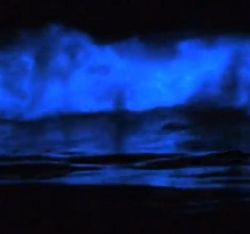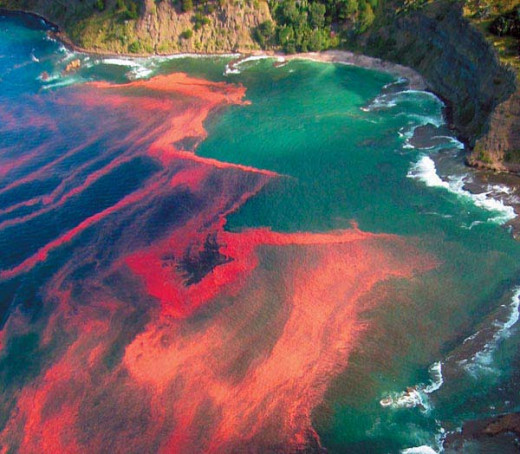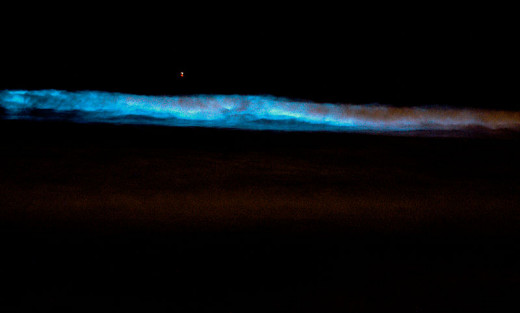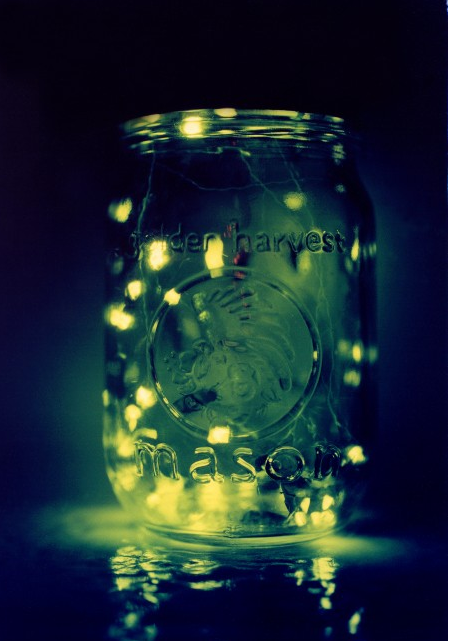Red Tide
Blooming Algae

Blooming Algae Create Electric Blue Waves
Beautiful shots of a glowing, living ocean are quite awesome to behold! But is this really a good thing?
It depends, according to scientists, on whether you are human or fish, and how much of this glowing algae is present. It can be known to clog up the shores and choke the oxygen in the water, effectively suffocating small shellfish.
But in small quantities, such as in the videos in this lens taken off the coast of California in a Red Tide event in September, 2011, it is harmless, other than a bit of discomfort and a foul smell.
Let's take a look at what causes this mysterious glow in the waves and whether or not we need to be concerned about it.
Photo: Screenshot from video by Loghan Call. See Below
Red Tide - Bioluminescent San Diego, 2011 - by LoghanCall
Beautiful capture of the waves with Spies by Coldplay in the background - an eerily wise choice. I suspect he chose it because of this line, which is repeated throughout the song:
"and the spies came out of the water.... but you're feeling so bad 'cause you know"
What we "know" in this case is that these funky neon blue algae types are toxic.... so there is that!
The waves "disturb" the algae with their motion, which sets off a type of alarm and causes them to glow.
NOAA Says
This is about the ones I've seen, and they are really pretty, but.....
One of the best known HABs in the nation occurs nearly every summer along Florida’s Gulf Coast. This bloom, like many HABs, is caused by microscopic algae that produce toxins that kill fish and make shellfish dangerous to eat. The toxins may also make the surrounding air difficult to breathe. National Oceanic and Atmospheric Administration
Not all algal blooms are harmful. Most blooms are good little plants which are the main source of food for ocean animals.

Tiny Organisms
Lingulodinium Polyedrum
The blue glow is created by tiny little organisms called Lingulodinium Polyedrum. It is a chemical reaction which creates the blue glow at night, which is not visible in daylight. They are really a red color, which is why they are called "Red Tide". It's kind of yucky stuff really, and you don't really want to get it in your eyes or ears, or swallow it either. The type of phytoplankton in this "Red Tide" won't kill you but it's nasty stuff, and it has a foul smell to it.
There are some types of Red Tide which are much more harmful. Always be careful before venturing out into waters with Red Tide. Check with your local authorities to be sure it is safe.
"Marine and fresh waters teem with life, much of it microscopic, and most of it harmless; in fact, it is this microscopic life on which all aquatic life ultimately depends for food" from Harmful Algae Blooms (HAB)
Photo by Miriam Godfrey
Seriously Spectacular Flashes of Light
"When jostled, each organism will give off a flash of blue light created by a chemical reaction within the cell. When billions and billions of cells are jostled - say, by a breaking wave - you get a seriously spectacular flash of light."
Peter Franks - Deep Sea News
Experimenting with Lingulodinium Polyedrum
With a length of barely 2~3 millimeters, when external stimulus is received, it discharges a luminous substance. Our camera caught the shining of the mysterious marine blue beautifully. (loose Japanese translation of description below video)
The author filmed his hand dipped in the algae which causes red tide, and was able to show close up how they react to external stimuli.
Red, Waves and Blue

Astonishing!
This microscopic phytoplankton proves that even tiny organisms, in huge numbers – often two million cells per one litre of water – can produce astonishing and fascinating results.
....EnvironmentalGraffitti.com
Kayaking the Red Tide - Tim King & Ryan Lum
Mission Bay, San Diego Sep 28, 2011
But How do they Create that Light? - What makes Lightning Bugs Light?

Resources on Red Tide - Used in this HUB
- Red Tide off California Coast Creates Blue Glow - ABC News
Red tide at Moonlight Beach in Encinitas, Calif. North County Times/Zuma Press/Newscom It’s best seen at night. In the Pacific Ocean off San Diego, masses of algae have bloomed to form what’s known as a red tide. By and large, it is not considered a - Neon Blue Waves Attract Night Surfers in San Diego
People living along the coast see the blue waves of the ocean every day, but only once a year do they get to see neon blue waves. Late summer algae blooms, - The San Diego red tide: FAQ from Scripps professor Dr. Peter Franks | Deep Sea News
This is a guest post modified from two emails by professor of biological oceanography Peter Franks, reprinted here with his permission. Peter is a - Lingulodinium polyedrum - Wikipedia, the free encyclopedia
Lingulodinium polyedrum Lingulodinium polyedrumL polyedrum in the surf off Solana Beach, California on 25 September 2011. (Exposure: 3 sec / f4 / ISO 3200 / f 210 mm) - Red Tide Causes Glow-In-The-Dark Blue Waves On San Diego Beaches (VIDEOS)
Huffington Post
Apparently it is the same process in both: Bioluminescence
Here's Wikipedia's answer:
"The enzyme luciferase acts on luciferin,
in the presence of magnesium ions,
ATP (adenosene triphosphate),
and oxygen to produce light."
Okey Dokey?
Let's try it in a little more plain English:
"The cells contain a chemical called luciferin and make an enzyme called luciferase. To make light, the luciferin combines with oxygen to form an inactive molecule called oxyluciferin. The luciferase speeds up the reaction"
That's a little better! From HowStuffWorks.com
So Luciferase, is the light switch, that turns on the oxyluciferin. Cool!
Might make a fun science project.



